Strategic Options Board Paper for Champion Homes
Added on 2023-06-04
23 Pages6094 Words55 Views
Assessment Task 3: Strategic Options Board Paper
Prepared for: Kenton Smith (Corporate Strategy and Responsibility)
Submitted: 11/09/2018
Prepared by: Simon Malesev
Student ID: SS-0000596
Prepared for: Kenton Smith (Corporate Strategy and Responsibility)
Submitted: 11/09/2018
Prepared by: Simon Malesev
Student ID: SS-0000596
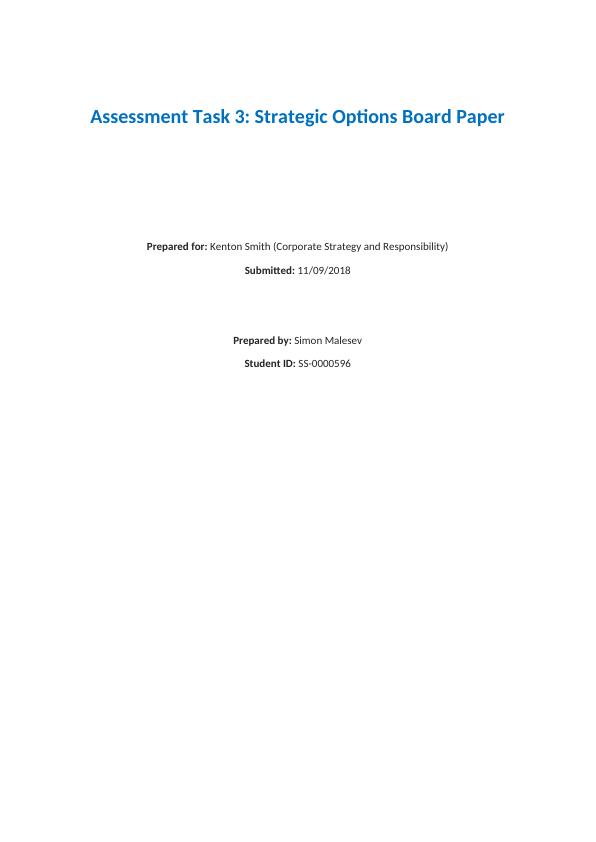
Table of Contents
Part 1 – Strategic Issue Analysis.............................................................................................................3
Executive Summary...........................................................................................................................3
Key Strategic Issues...........................................................................................................................3
Conclusion.......................................................................................................................................11
Part 2 – CEO Leadership Paper............................................................................................................13
The LMAP Experience......................................................................................................................13
Strengths.........................................................................................................................................13
Areas of Improvement.....................................................................................................................14
Champion Homes a new CEO..........................................................................................................15
Leadership Goals.............................................................................................................................16
Professional Development Plan.......................................................................................................16
Conclusion.......................................................................................................................................17
Appendices......................................................................................................................................18
Figure 1. HIA Housing Forecasts – August 2018...............................................................................18
Figure 2. Industry performance.......................................................................................................18
Figure 3. NSW building and population hotspots............................................................................19
Figure 4. First Home Buyer growth..................................................................................................19
Figure 5. Trade availability...............................................................................................................20
Figure 6. Four I’s of transformational leadership.............................................................................21
Figure 7. The seven levels of leadership consciousness...................................................................22
References.......................................................................................................................................23
Part 1 – Strategic Issue Analysis.............................................................................................................3
Executive Summary...........................................................................................................................3
Key Strategic Issues...........................................................................................................................3
Conclusion.......................................................................................................................................11
Part 2 – CEO Leadership Paper............................................................................................................13
The LMAP Experience......................................................................................................................13
Strengths.........................................................................................................................................13
Areas of Improvement.....................................................................................................................14
Champion Homes a new CEO..........................................................................................................15
Leadership Goals.............................................................................................................................16
Professional Development Plan.......................................................................................................16
Conclusion.......................................................................................................................................17
Appendices......................................................................................................................................18
Figure 1. HIA Housing Forecasts – August 2018...............................................................................18
Figure 2. Industry performance.......................................................................................................18
Figure 3. NSW building and population hotspots............................................................................19
Figure 4. First Home Buyer growth..................................................................................................19
Figure 5. Trade availability...............................................................................................................20
Figure 6. Four I’s of transformational leadership.............................................................................21
Figure 7. The seven levels of leadership consciousness...................................................................22
References.......................................................................................................................................23
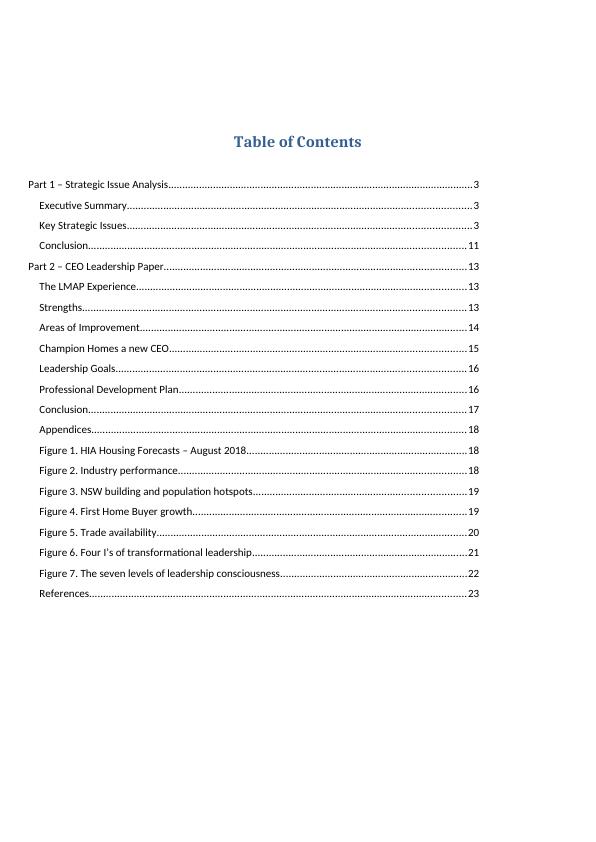
Part 1 – Strategic Issue Analysis
Executive Summary
Australia’s 28 years of growth has been built on the back of a serious of booms in different economic sectors
(HIA. 2018). It is without a doubt that the infrastructure and population booms are the underpinnings of
construction activity across the nation, with major projects underway in New South Wales and Victoria.
Investment is also ramping up in other states. Significant investments are being made in roads, rail, water,
telecommunications, and airports.
The nations population growth is defining fuel for an increase in infrastructure. However, the residential
property market has peaked, and we are now starting to see a fall in local and foreign investment. This being
said first home buyer participation has reached a six-year high (see fig.4 First home buyer growth)
Nonetheless, there are still several thousands of housing projects and apartment towers that must be
completed in the next 2-3 years. The principal focus of residential construction companies has shifted towards
sustainable and high-end luxury apartments with the consistent expansion of regional townships and
surrounding suburbs of our capital cities known as the hotspots. (See fig.3 NSW building and population
hotspots)
Given that Champion Homes is a medium-sized player in the construction industry, it faces critical strategic
issues due to the changing industry trends. The three strategic issues that Champion may experience in the
next five years include a shortage of skilled and qualified trades, technological changes that affect business
operations and the need for improving sustainability in the sector, which has become a major global factor.
These issues need to be investigated to see where potential risks threats and opportunities may arise.
Key Strategic Issues
SHORTAGE OF SKILLED AND QUALIFIED TRADES
Undoubtedly, the construction industry experienced a boom over the last few years and this is
expected to have an impact over the next three years on primary level (Ashworth & Perera, 2018).
Despite this growth, over 70% of contractors reported that find it difficult to recruit skilled and
qualified construction workers to fill the increasing vacancies in the sector (Chileshe, Karuppannan,
Trasente & Sivam, 2017). There is a significant level of misalignment between the available jobs and
the available skilled workers; a trend that is projected to continue in the industry (Heaton, 2017).
Executive Summary
Australia’s 28 years of growth has been built on the back of a serious of booms in different economic sectors
(HIA. 2018). It is without a doubt that the infrastructure and population booms are the underpinnings of
construction activity across the nation, with major projects underway in New South Wales and Victoria.
Investment is also ramping up in other states. Significant investments are being made in roads, rail, water,
telecommunications, and airports.
The nations population growth is defining fuel for an increase in infrastructure. However, the residential
property market has peaked, and we are now starting to see a fall in local and foreign investment. This being
said first home buyer participation has reached a six-year high (see fig.4 First home buyer growth)
Nonetheless, there are still several thousands of housing projects and apartment towers that must be
completed in the next 2-3 years. The principal focus of residential construction companies has shifted towards
sustainable and high-end luxury apartments with the consistent expansion of regional townships and
surrounding suburbs of our capital cities known as the hotspots. (See fig.3 NSW building and population
hotspots)
Given that Champion Homes is a medium-sized player in the construction industry, it faces critical strategic
issues due to the changing industry trends. The three strategic issues that Champion may experience in the
next five years include a shortage of skilled and qualified trades, technological changes that affect business
operations and the need for improving sustainability in the sector, which has become a major global factor.
These issues need to be investigated to see where potential risks threats and opportunities may arise.
Key Strategic Issues
SHORTAGE OF SKILLED AND QUALIFIED TRADES
Undoubtedly, the construction industry experienced a boom over the last few years and this is
expected to have an impact over the next three years on primary level (Ashworth & Perera, 2018).
Despite this growth, over 70% of contractors reported that find it difficult to recruit skilled and
qualified construction workers to fill the increasing vacancies in the sector (Chileshe, Karuppannan,
Trasente & Sivam, 2017). There is a significant level of misalignment between the available jobs and
the available skilled workers; a trend that is projected to continue in the industry (Heaton, 2017).
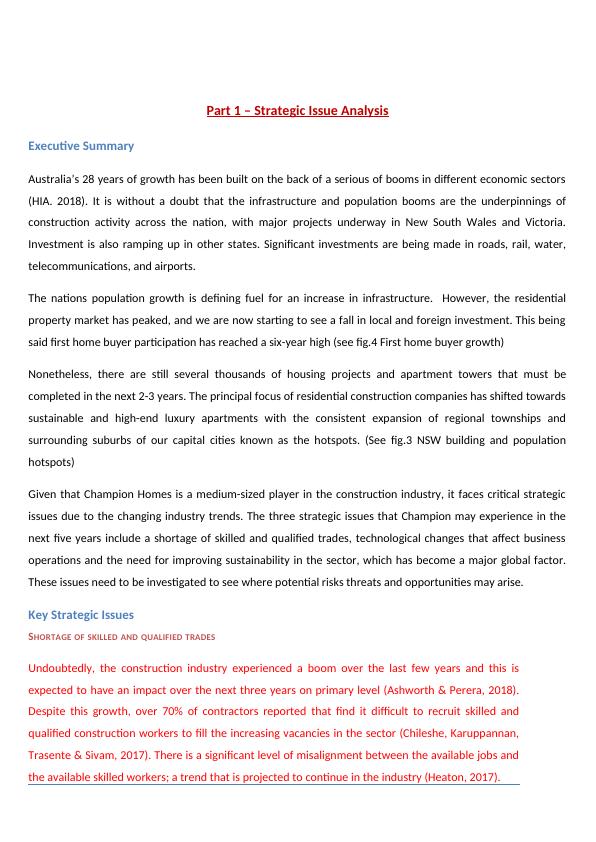
In spite of these trends, the sector is a significant employer in the Australian economy. There are
over 1.168 million employed in the construction industry, a figure that is adjustable seasonally
(Veen, Teicher & Holland, 2017). This translated to an additional 100 00 workers to the industrial
payroll in 2017 (Cameron, Burgess, Dhakal, Fitzgerald & Ayentimi, 2017). Besides, Australia’s
construction industry is still a strong economic driver as it demands consistent staffing (Heaton,
2017). However, the skill needs in the industry are on the rise. For instance, the numerous
residential projects that Champion Homes is undertaking calls for construction managers, project
managers and contract administrators (First Focus IT, 2018). There are more opportunities in the
residential subsector according to Sydney Housing Supply Forecasts, which project that about
180,000 new homes will be constructed in Sydney in the next five years. Champion Homes has also
seen an increase in projects in civil and commercial subsectors. The company needs an adequate
supply of skilled and experienced site managers, project engineers and foremen.
One of the causes of a skilled labor shortage in the construction industry is the Australian aging
population. One in every four Australian is aged above 55 years, a trend that will worsen in ten
years’ time, when one in every three Australian will clock the same age (Gahan and Healy, 2017).
Worse still, the younger generation does not appreciate careers in the construction industry, which
causes them not to pursue professional careers in the same (Ashworth & Perera, 2018). This
shortage makes the available skilled labor quite expensive for the players (Chileshe et al., 2017). In
response, employers in the sector have increased pay, provided additional benefits and provided
training as a retention strategy (Liu, Love, Sing, Carey & Matthews, 2014). This, however, has not
fully resolved the skilled labor shortage crisis and as the industry grows, the demand for resolving it
increases. These trends imply that as a player in the industry, Champion Homes will have to contend
with the lack of qualified construction worker to help in handling its projects. This may be the reality
for Champion for the next 1 – 7 years (See Figure 5 on Trade Availability).
Risks
The aging workforce may demand policies in regards to healthcare, social welfare, and
retirement (Gahan and Healy, 2017). This may affect Champion Homes in terms of the costs
of operation that may undercut profitability.
Capacity constraints in the construction industry (Gahan and Healy, 2017). This may inhibit
Champion Homes from undertaking projects in which they are under-resourced to
accomplish.
over 1.168 million employed in the construction industry, a figure that is adjustable seasonally
(Veen, Teicher & Holland, 2017). This translated to an additional 100 00 workers to the industrial
payroll in 2017 (Cameron, Burgess, Dhakal, Fitzgerald & Ayentimi, 2017). Besides, Australia’s
construction industry is still a strong economic driver as it demands consistent staffing (Heaton,
2017). However, the skill needs in the industry are on the rise. For instance, the numerous
residential projects that Champion Homes is undertaking calls for construction managers, project
managers and contract administrators (First Focus IT, 2018). There are more opportunities in the
residential subsector according to Sydney Housing Supply Forecasts, which project that about
180,000 new homes will be constructed in Sydney in the next five years. Champion Homes has also
seen an increase in projects in civil and commercial subsectors. The company needs an adequate
supply of skilled and experienced site managers, project engineers and foremen.
One of the causes of a skilled labor shortage in the construction industry is the Australian aging
population. One in every four Australian is aged above 55 years, a trend that will worsen in ten
years’ time, when one in every three Australian will clock the same age (Gahan and Healy, 2017).
Worse still, the younger generation does not appreciate careers in the construction industry, which
causes them not to pursue professional careers in the same (Ashworth & Perera, 2018). This
shortage makes the available skilled labor quite expensive for the players (Chileshe et al., 2017). In
response, employers in the sector have increased pay, provided additional benefits and provided
training as a retention strategy (Liu, Love, Sing, Carey & Matthews, 2014). This, however, has not
fully resolved the skilled labor shortage crisis and as the industry grows, the demand for resolving it
increases. These trends imply that as a player in the industry, Champion Homes will have to contend
with the lack of qualified construction worker to help in handling its projects. This may be the reality
for Champion for the next 1 – 7 years (See Figure 5 on Trade Availability).
Risks
The aging workforce may demand policies in regards to healthcare, social welfare, and
retirement (Gahan and Healy, 2017). This may affect Champion Homes in terms of the costs
of operation that may undercut profitability.
Capacity constraints in the construction industry (Gahan and Healy, 2017). This may inhibit
Champion Homes from undertaking projects in which they are under-resourced to
accomplish.
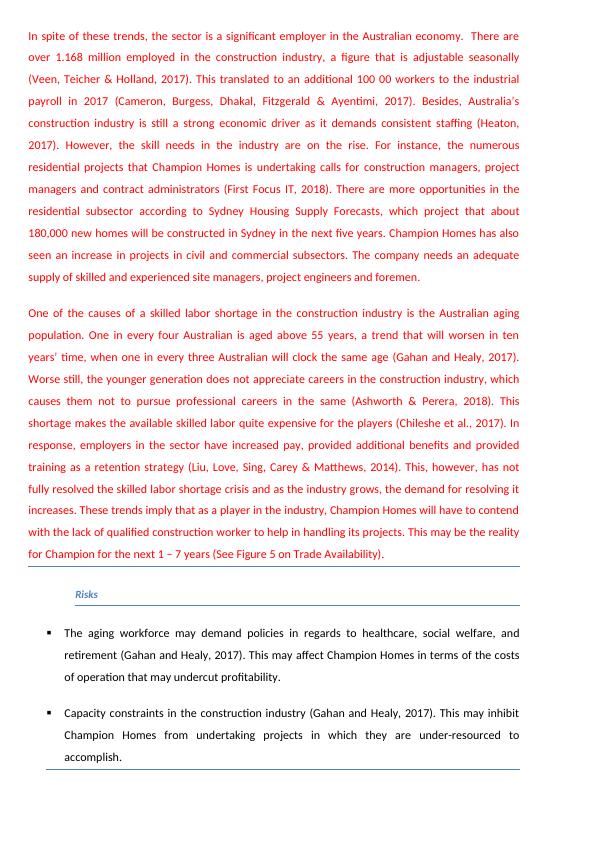
The need for making the workforce skills requirements less strict to generate enough
personnel for short-term employment (Heaton, 2017). This may affect Champion Homes in
terms of incurring costs in training the under-skilled and unskilled labor.
Project Labour Agreements (PLA) could become restrictive and complex (Veen et al., 2017).
This may affect Champion Homes in terms of its relationship to the staff, who may be more
demanding in terms of remuneration and benefits.
Opportunities
Construction companies can leverage on the shortage of skilled labor to retain their
competent personnel and thus achieve a competitive edge in the industry. (Cameron et al.,
2017). Champion Homes can achieve competitiveness through retaining its skilled and
experienced labor by adopting effective retention strategies such as proper remuneration,
flexible working hours and providing training to upscale skills.
The expansion of the labor pool through providing training opportunities, and reducing the
prerequisites for work qualifications (Heaton, 2017). This will enable Champion Homes to
identify itself as a sound employer in the market with opportunities for prospective employers
who have no skills for the sector.
Threats
Restrictive pension scheme provisions that mandate employers to participate in as a legal obligation
(Gahan and Healy, 2017). Champion Homes will have to develop a contingency plan that considers the
variable age pension options as a matter of necessity.
Semi unskilled, unqualified and aging employees will face exhaustion and frustration at work (Gahan
and Healy, 2017). Champion Homes may find this cadre of employees slowing down projects or giving
poor quality output.
Lack of quality training and workforce experience, resulting in poor exposure, the higher rate of
worker injuries and potential third-party liability (Cameron et al., 2017). This exposes Champion
Homes to litigation that may result in higher compensation claims for workers
TECHNOLOGY AND THE WAY WE DO BUSINESS
Evidently, most big construction companies are embracing technology. However, this will take time before it
becomes an industry-wide standard. Many construction companies are relatively slow in adopting new
technology (Wang & Chong, 2015). The vast number of software has been adopted by construction
personnel for short-term employment (Heaton, 2017). This may affect Champion Homes in
terms of incurring costs in training the under-skilled and unskilled labor.
Project Labour Agreements (PLA) could become restrictive and complex (Veen et al., 2017).
This may affect Champion Homes in terms of its relationship to the staff, who may be more
demanding in terms of remuneration and benefits.
Opportunities
Construction companies can leverage on the shortage of skilled labor to retain their
competent personnel and thus achieve a competitive edge in the industry. (Cameron et al.,
2017). Champion Homes can achieve competitiveness through retaining its skilled and
experienced labor by adopting effective retention strategies such as proper remuneration,
flexible working hours and providing training to upscale skills.
The expansion of the labor pool through providing training opportunities, and reducing the
prerequisites for work qualifications (Heaton, 2017). This will enable Champion Homes to
identify itself as a sound employer in the market with opportunities for prospective employers
who have no skills for the sector.
Threats
Restrictive pension scheme provisions that mandate employers to participate in as a legal obligation
(Gahan and Healy, 2017). Champion Homes will have to develop a contingency plan that considers the
variable age pension options as a matter of necessity.
Semi unskilled, unqualified and aging employees will face exhaustion and frustration at work (Gahan
and Healy, 2017). Champion Homes may find this cadre of employees slowing down projects or giving
poor quality output.
Lack of quality training and workforce experience, resulting in poor exposure, the higher rate of
worker injuries and potential third-party liability (Cameron et al., 2017). This exposes Champion
Homes to litigation that may result in higher compensation claims for workers
TECHNOLOGY AND THE WAY WE DO BUSINESS
Evidently, most big construction companies are embracing technology. However, this will take time before it
becomes an industry-wide standard. Many construction companies are relatively slow in adopting new
technology (Wang & Chong, 2015). The vast number of software has been adopted by construction
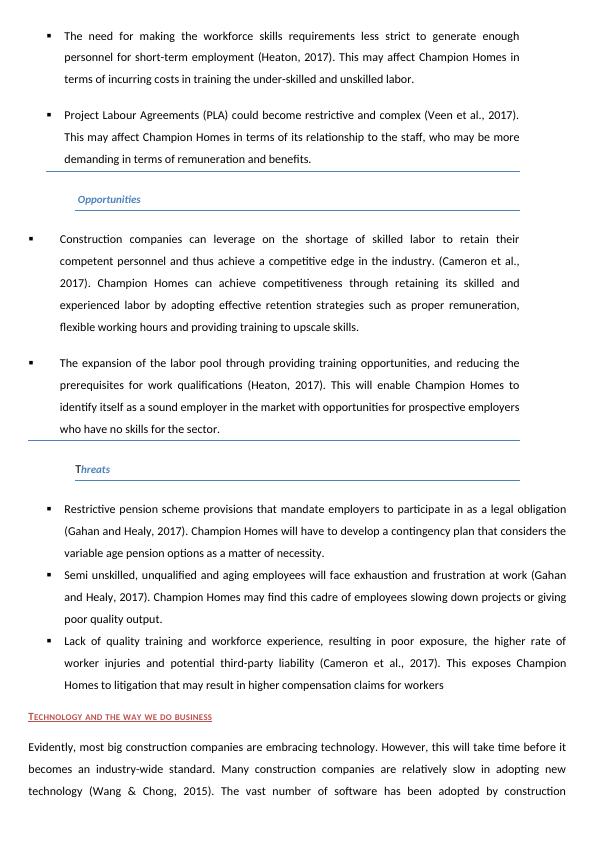
companies, which provide a broad range of services including document management and online invoicing.
Currently, document management is widely adopted with providers meeting the DoD5015.2 and VERS
standards, making it easier to capture, share and store industry data. However, there is a need for making an
adjustment to address the needs of all industry players (Ashworth & Perera, 2018).
One of the way technology affects the industry regards the choice of company materials. For instance, cost-
cutting is a key motivator for change. Companies make decisions based on new products regarding cost
reduction (Sepasgozar, Davis, Loosemore & Bernold, 2018). In turn, adopting new products and technologies
render old construction methods obsolete or scarce. This results in an increased cost to the consumer,
exemplified by the costly double brick party-walls that have now been replaced with CSR and Boral party-wall
systems. (Wang & Chong, 2015)
Champion Homes is at the forefront of the industry when it comes to technological advancements. The
company has invested in the state of the art, patent pending bespoke software, which it has developed by
itself. The company has also acquired the cloud-based technology to help in the management of its
information system. However, Champion Homes need to be strategic while implementing new technology
because it cannot take the chance to upset the veteran employees who have established perspectives about
the traditional business methods.
Risks
Inadequate education on new technologies on the employees and partners (Loosemore, 2015).
This inhibits Champion Homes’ personnel from taking advantage of the existing technologies to
enhance its productivity and efficiency.
The traditional industry culture that results in resistance to changes brought about by
technological advancements (Sepasgozar et al., 2018), such as working within integrated teams
and sharing large data (Ashworth & Perera, 2018). Through these established culture
Currently, document management is widely adopted with providers meeting the DoD5015.2 and VERS
standards, making it easier to capture, share and store industry data. However, there is a need for making an
adjustment to address the needs of all industry players (Ashworth & Perera, 2018).
One of the way technology affects the industry regards the choice of company materials. For instance, cost-
cutting is a key motivator for change. Companies make decisions based on new products regarding cost
reduction (Sepasgozar, Davis, Loosemore & Bernold, 2018). In turn, adopting new products and technologies
render old construction methods obsolete or scarce. This results in an increased cost to the consumer,
exemplified by the costly double brick party-walls that have now been replaced with CSR and Boral party-wall
systems. (Wang & Chong, 2015)
Champion Homes is at the forefront of the industry when it comes to technological advancements. The
company has invested in the state of the art, patent pending bespoke software, which it has developed by
itself. The company has also acquired the cloud-based technology to help in the management of its
information system. However, Champion Homes need to be strategic while implementing new technology
because it cannot take the chance to upset the veteran employees who have established perspectives about
the traditional business methods.
Risks
Inadequate education on new technologies on the employees and partners (Loosemore, 2015).
This inhibits Champion Homes’ personnel from taking advantage of the existing technologies to
enhance its productivity and efficiency.
The traditional industry culture that results in resistance to changes brought about by
technological advancements (Sepasgozar et al., 2018), such as working within integrated teams
and sharing large data (Ashworth & Perera, 2018). Through these established culture
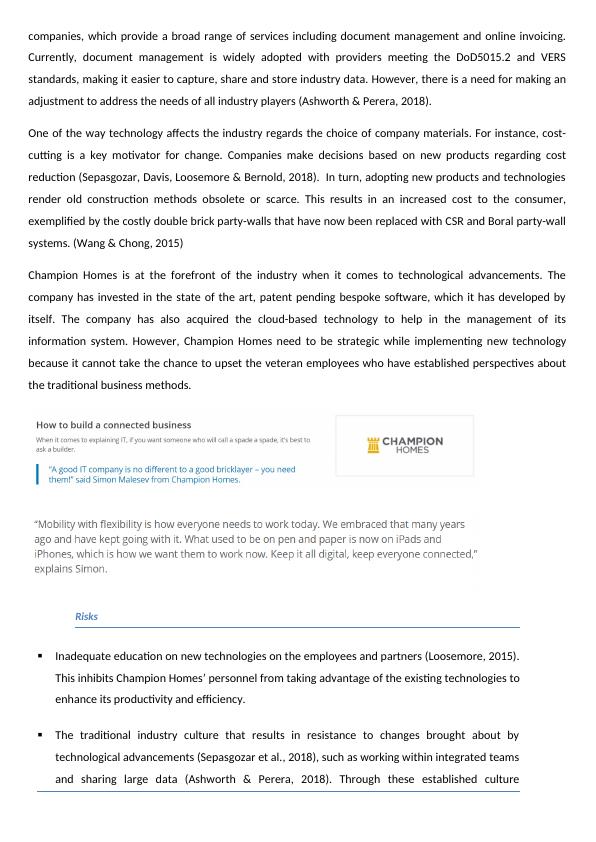
End of preview
Want to access all the pages? Upload your documents or become a member.
